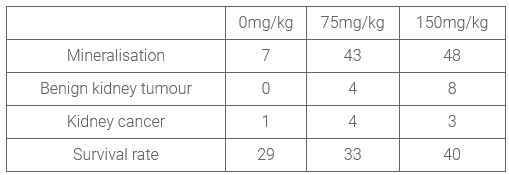Dispelling the "Rats can't eat Citrus" myth
There are many, many myths and misconceptions about what rats can and can’t eat. One of the most pervasive is that orange, orange juice or other citrus fruits will give your rats cancer.
In some versions of this misconception, it’s only male rats that are affected, and in others it’s not cancer, but kidney failure that results. We'll discuss all of this and break things down piece by piece, since the claim is false in a practical sense, but is based on real data that has been misinterpreted.
D-limonene is a common chemical. You’ve smelled and eaten it before, it’s the main fragrance in orange peels! It’s sold as a dietary supplement, used in cosmetics and many orange/citrus flavoured or scented products, and concentrated D limonene is used to remove sticky residue from bottles - you might have a bottle of it under your sink. It's one of the most common terpenes in existence and is found in high concentration in many other edible plants such as cumin, dill seeds and bergamot.
When a product such as the 'D-limonene goo remover' is being researched and developed, or a chemical is being tested to determine its effects on humans, rats are the most common test subject. This creates an extensive library of studies showing the effects of certain substances on rats, usually at extremely high concentrations nowhere near what could be achieved dietarily. Unfortunately, without the training to interpret the context of the study, well meaning pet owners can stumble across these studies and make assumptions about the way they apply to practical rat keeping.
Let's look into D-limonene studies and see where these ideas are coming from.
It is established that D-limonene is a carcinogenic agent in male rats specifically! This is because of the way the D-limonene interacts with a drug-binding protein called alpha-2u-globulin, which, interestingly, doesn't occur with the similar proteins in mice or humans. Now before anyone says "See, I told you so!" let's look at this critically. Alpha-2u-globulin is a drug binding protein, it's doing it's job perfectly and this job isn't solely related to D-limonene, there are a wide range of chemicals that are processed the same way. For D-limonene specifically the binding process is completely reversed as the D-limonene is processed, and even in male rats, is gone after 48 hours even at extremely high doses.
So where does the cancer-causing statistic come from then? Let's look at the US Department of Health's official report on D-limonene. Groups of male vs female and rats vs mice, were given either 0, 75 or 150mg/kg of pure D-limonene, 5 days a week, for 2 years. That's 50 animals per dose, in two species, in two sexes, for a total of 600 animals. Looking at the incidences of mineralisation and neoplastic effects (abnormal cell growth, such as tumour or cancer), in 50 male rats per group, for a total of 150 rats:
Issues in male rats in a 2 year study, number of rats in each group is 50
So we can see a trend! The rats given more D-limonene had more kidney issues, and the paper says these effects, and other kidney issues, were ONLY seen in the male rat group, and not in the 150 female rats, female mice, or male mice, which they listed as "none" across the board. But hang on, the male rats given NO D-limonene still had a base rate of kidney issues, right? That's normal and expected in a control group, health issues happen. Looking at the rest, we've got 150 female rats and 300 mice in total, so how many of them had kidney issues? According to the paper, NONE. Not a single bit of mineralisation, not one little lump, in 450 animals. As a biologist myself, I find that INCREDIBLY hard to believe given the base rate in the males. And look at the survival rate. If we're to believe the data, male rats were MORE likely to survive the full 2 years, the more D-limonene they had! This is the only time this trend was seen, in the other animal groups, survival rates were much lower for the D-limonene groups, which begs the question: given that the study itself mentions kidney neoplasias beign an age related disease - were the kidney issue rates affected by those animals not surviving long enough to study them?
By now you're hopefully getting the idea that there's something not adding up about this whole orange story. The statistics get even sketchier when it is claimed that rats contracted cataracts and retinal degeneration at a rate of nearly none in the control group, but increasing up to almost half the group in the high dose groups, in a manner that mimics the trend in the kidney issues (Cataracts: male: 0/50; 7/50; 37/50; female: 0/50; 21/50; 28/50) (Retinal degeneration: male: 1/50; 3/50; 27/50; female: 0/50; 5/50; 20/50). This doesn't mean that D-limonene caused the eye issues, the study points out that they didn't move or randomise the cages, so the groups were stored in a way where the higher dose groups where much closer to the very bright lights of the lab. What this means for us is that the study was poorly conducted, and didn't factor in gradients that could have a large, measurable effect on the animals heath and stress levels. We know bright light can affect stress, sleep patterns and metabolism, it would be unrealistic to assume this wouldn't affect the study at all.
How does this apply to real life? Will your rats go into kidney failure if they steal a drink of your orange juice? It may seem a silly question but it's one I've seen dozens of times in rat community groups with people either panicking because their rat ate some fruit salad, or others jumping on an owner showing a picture of a rat sharing some OJ, and that panic and stress alone makes this worth analyzing critically.
Let's break down some math, on male rats specifically. We know that 800mg/kg of pure D-limonene is completely processed and gone from the kidneys after 48 hours. There is an average of 1300mg of D-limonene from the peel of a whole orange. Let's assume that the average male rat is around 500g, which would mean the rat must eat the peel of a quarter of an orange to reach the levels I've just referenced, and even then 48 hours later, there is absolutely no trace left. I've never met a rat who would eat orange peel, because rats understand what is, and isn't food.
But what about orange juice, I hear you say? The oil can get into the juice, what if someone fed their rat orange juice every day? Could that have any effect?
Unrealistic, but I'll bite. Orange juice contains 57mg/kg D-limonene. Assuming a rough weight of 1g/L that's 22.8L of orange juice to achieve the same amount of D-limonene as a single orange. To achieve the D-limonene levels used in the mid-range group of the study, your rat would need to drink approximately one and a half litres of orange juice every day. To achieve the 800mg/kg that is completely gone from the body in 48h, that's nearly 6 litres. You get my drift?
So, what do we know? There is evidence, (very poor quality evidence in my opinion), that high quantities of D-limonene given daily is linked to kidney issues in male rats. The mechanism for this is known, and doesn't affect female rats, any mice or any humans. Is it practical knowledge? No. Rats cannot physically drink enough orange juice per day to consume a significant amount of D-limonene. As for oranges, unless your rat is eating large amounts of straight orange peel (in which case I would be taking them to the vet for a discussion about pica), there's really no danger in your rat having a bite of your fruit salad, a lick of your orange juice, or stealing a bit of a choc orange.
I hope that helps to shed light on the misconceptions surrounding oranges, and how science can sometimes be taken out of context and cause issues.
If you have any additions or corrections, please feel free to send us an email! I love learning new things. Thanks for reading!
Article by Grover Greenfield


